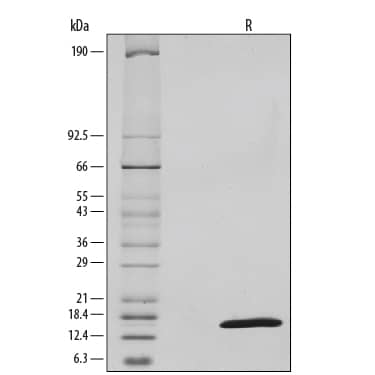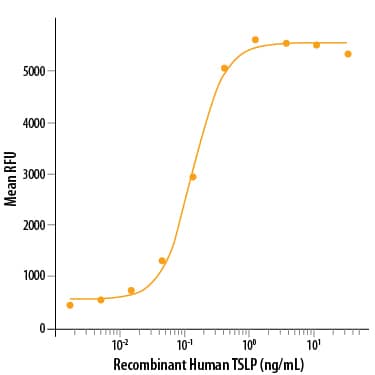Recombinant Human TSLP Protein Best Seller
R&D Systems, part of Bio-Techne | Catalog # 1398-TS

Key Product Details
Product Specifications
Source
Tyr29-Gln159, with an N-terminal Met
Purity
Endotoxin Level
N-terminal Sequence Analysis
Predicted Molecular Mass
Activity
The ED50 for this effect is 0.05-0.3 ng/mL.
Reviewed Applications
Read 2 reviews rated 4 using 1398-TS in the following applications:
Scientific Data Images for Recombinant Human TSLP Protein
Recombinant Human TSLP Protein Bioactivity
Recombinant Human TSLP (Catalog # 1398-TS) stimulates cell proliferation in the BaF3 mouse pro-B cell line transfected with human IL-7 R alpha and human TSLP R. The ED50 for this effect is 0.05-0.3 ng/mL.Recombinant Human TSLP Protein SDS-PAGE
1 μg/lane of Recombinant Human TSLP was resolved with SDS-PAGE under reducing (R) conditions and visualized by silver staining, showing a single band at 14 kDa.Formulation, Preparation and Storage
Carrier Free
What does CF mean?CF stands for Carrier Free (CF). We typically add Bovine Serum Albumin (BSA) as a carrier protein to our recombinant proteins. Adding a carrier protein enhances protein stability, increases shelf-life, and allows the recombinant protein to be stored at a more dilute concentration. The carrier free version does not contain BSA.
What formulation is right for me?In general, we advise purchasing the recombinant protein with BSA for use in cell or tissue culture, or as an ELISA standard. In contrast, the carrier free protein is recommended for applications, in which the presence of BSA could interfere.
Carrier: 1398-TS
| Formulation | Lyophilized from a 0.2 μm filtered solution in PBS with BSA as a carrier protein. |
| Reconstitution | Reconstitute at 100 μg/mL in sterile PBS containing at least 0.1% human or bovine serum albumin. |
| Shipping | The product is shipped at ambient temperature. Upon receipt, store it immediately at the temperature recommended below. |
| Stability & Storage | Use a manual defrost freezer and avoid repeated freeze-thaw cycles.
|
Carrier Free: 1398-TS/CF
| Formulation | Lyophilized from a 0.2 μm filtered solution in PBS. |
| Reconstitution | Reconstitute at 100 μg/mL in sterile PBS. |
| Shipping | The product is shipped at ambient temperature. Upon receipt, store it immediately at the temperature recommended below. |
| Stability & Storage | Use a manual defrost freezer and avoid repeated freeze-thaw cycles.
|
Background: TSLP
Thymic Stromal Lymphopoietin (TSLP) was originally identified as an activity from the conditioned medium of a mouse thymic stromal cell line that promoted the development of B cells (1 - 3). The activities of mouse TSLP overlap with, but are distinct from, those of mouse IL-7. Both mouse TSLP and IL-7 can co-stimulate growth of thymocytes and mature T cells, and support B lymphopoiesis in long-term cultures of fetal liver cells and bone-marrow cells. Whereas mouse IL-7 facilitates the development of B220+/IgM- pre-B cells, mouse TSLP promotes the development B220+/IgM+ B cells. Human TSLP was reported to preferentially stimulate myeloid cells; inducing the release of T cell-attracting chemokines from monocytes and enhancing the maturation of CD11c+ dendritic cells. Human TSLP cDNA encodes a 159 amino acid (aa) residue precursor protein with a 28 aa signal sequence (4, 5). Within the mature region, six of the seven cysteine residues present in the mouse TSLP involved in intramolecular disulfide bond formation are conserved in the human TSLP. Human TSLP shares approximately 43% aa sequence identity with mouse TSLP. By Northern blot analysis, human TSLP expression has been detected in many tissues with the highest expressions in heart, liver, testis and prostate. TSLP signals through a heterodimeric receptor complex that consists of IL-7 R alpha and the TSLP R, a member of the hemopoietin receptor family most closely related to R gammac.
References
- Sims, J.E. et al. (2000) J. Exp. Med. 192:671.
- Park, L.S. et al. (2000) J. Exp. Med. 192:659.
- Pandey, A. et al. (2000) Nature Immunol. 1:59.
- Reche, P.A. et al. (2001) J. Immunol. 167:336.
- Quentmeier, H. et al. (2001) Leukemia 15:1286.
Long Name
Alternate Names
Gene Symbol
UniProt
Additional TSLP Products
Product Documents for Recombinant Human TSLP Protein
Product Specific Notices for Recombinant Human TSLP Protein
For research use only

